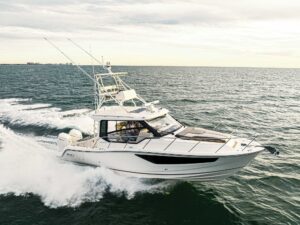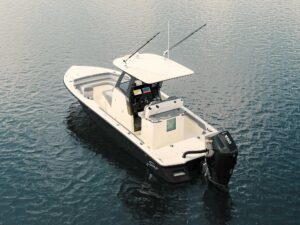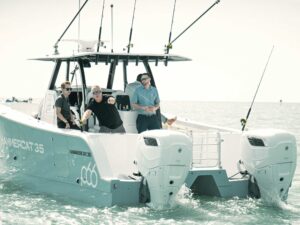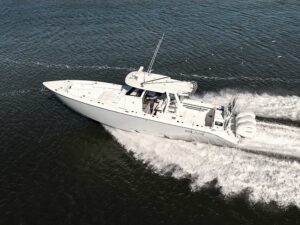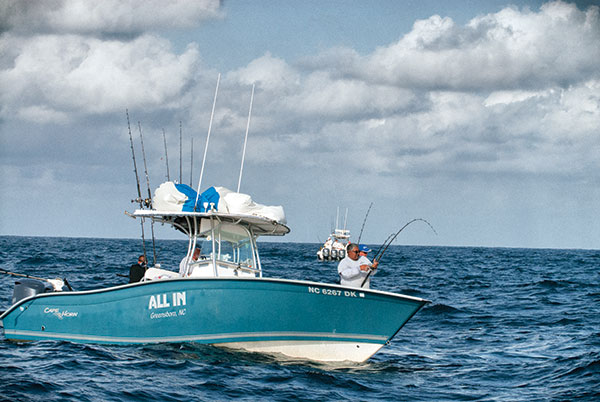
Center-console boats made their first appearance almost 50 years ago, and have undergone a constant evolution to be bigger, faster, and better equipped since that first 16-footer stole fishermen’s hearts. One driving force behind this evolution was the Southern Kingfish Association, developers of the largest saltwater tournament trail in the country. For the past 25 years, kingfish tournaments have stretched from the mid-Atlantic and into the Gulf of Mexico, and the rigors of competition keep boatbuilders busy upgrading their products to meet the demands of the teams that fish them.
The center console is the logical platform for fishing kings, where the techniques used to catch them range from trolling with downriggers to fishing with kites, often at the same time. The ideal kingfish boat has the features necessary to do it all, and surprisingly enough, it doesn’t have to be a 36- to 42-foot leviathan to get the job done.
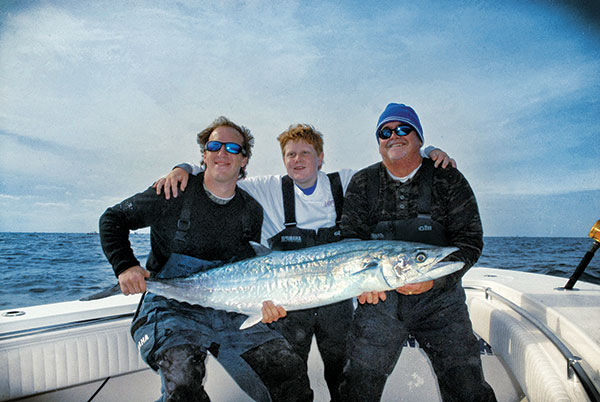
Sizing the Ride
Capt. Brant McMullan, of Team Ocean Isle Fishing Center, has years of experience fishing competitively, both in divisional and pro tournaments. His team has won the SKA Nationals an unprecedented three out of the last five years, and has scaled the largest kingfish ever weighed in SKA competition at 74 pounds. For the past few seasons, he has been fishing the open class in a 32-foot Yellowfin with twin Yamaha 300 outboards, while other pro teams are campaigning considerably larger triple- and quad-engine boats.
“After fishing 36-footers for years, I found everything I needed to compete in the big-boat class in the newest generation of 32s,” says McMullan. “Today’s midsize hulls are as tough and seaworthy as the bigger boats, and with twins, they offer plenty of speed while burning less fuel. It’s easier to trailer to tournaments, has plenty of range, there are only two engines to maintain, and it still has all the important fishing features I need to find and catch kingfish, or pretty much anything else I want to chase inshore or offshore.”
So what features make a center console a great kingfish boat? According to McMullan, there are few more critically important than the livewell systems.
“Fishing for kings requires live bait, and lots of it,” McMullan says. “Multiple livewells are a critical feature on a kingfish boat, at least two. Three is even better.” But it’s not just the number of livewells on board, it’s the size, shape, and water flow that are necessary to keep a host of different baitfish alive and well.
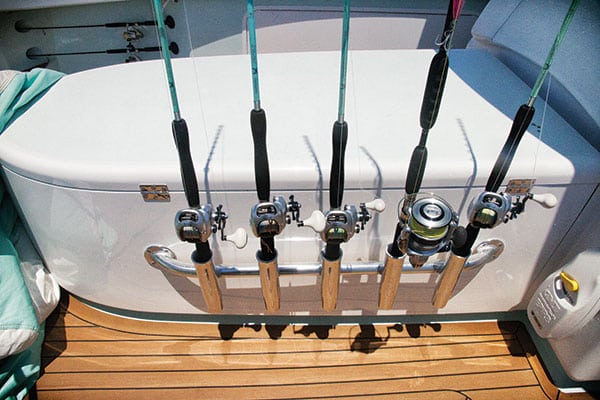
Keep ‘Em Kickin’
“We fish a variety of baitfish depending on where we are and the time of year,” McMullan says. “Some are pretty tender and hard to maintain, while others are hearty and almost impossible to kill, and they just can’t be mixed together. I like to use pilchards as live chum to get kingfish turned on, and you can’t keep them in the same tank with large hook baits because the scales get knocked off, clog up the return, and the bait dies.”
Menhaden — popular kingfish baits in the Carolinas and in some areas of the Gulf — are notoriously difficult to maintain. They have to be in a round or oval livewell with a circular water flow so they can swim in circles, or else they will bang into the walls and each other, get red noses, lose their slime, and become useless as bait. They require lots of water, at least a gallon per bait — more if the water is hot — and lots of water flow, says McMullan.
Even hardy baitfish like blue runners, goggle-eyes, cigar minnows, and mullet need room and water flow, and suffer from being tossed around in a livewell during the long runs in rough water often required to find kings. The latest improvements in design include the ability to pressurize livewells so they can be filled to very top. No air cavity means water won’t slosh around, tumbling the bait while running. This trick requires strong pumps with adjustable flow rates and the ability to restrict the amount of water exiting the well through the overflow line. Most builders of competition center consoles offer a range of livewell options, which can include multiple high-flow pumps inside a sea chest in the bilge with a manifold of valves to control water volume to each livewell, and a second set of valves to control the volume of water coming out of the overflow. It’s a balancing act to keep enough water moving through while maintaining the wells at no more than 1 or 2 pounds per square inch of pressure.
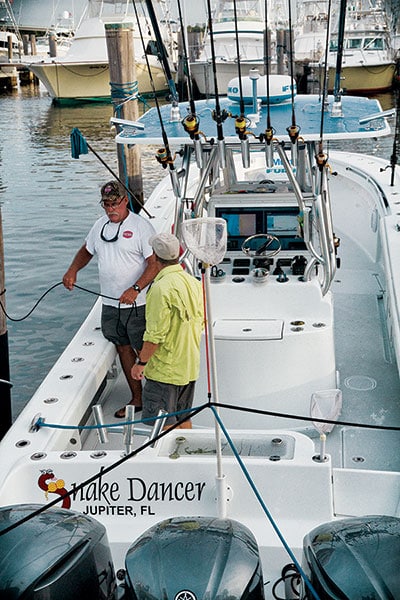
Little Things, Big Results
Capt. George Mitchell of Jupiter, Florida, fished the SKA pro division for years, in addition to being a highly sought-after charter captain. While on his boat during the National Championship in Biloxi, Mississippi, last year, he showed me a neat trick he uses to pressurize his livewells before making a long run. He makes small, sliding doors out of Starboard, which he screws in place over the overflow grill in each well. He slides them down, reducing outflow before making a run, and slides them open when he gets to his destination. It works like a charm, and his baitfish look as good at the end of the day as they did at the start.
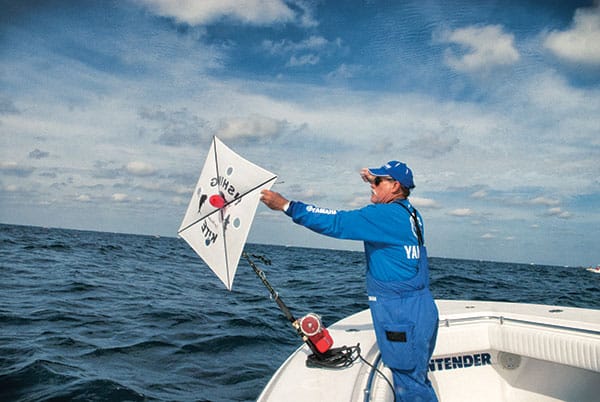
Mitchell is a big proponent of fishing with kites for a wide variety of gamefish, including tournament kingfish. It’s a technique that has become increasingly popular in recent years, and to do it right, you need rod holders around the entire perimeter of the boat and power outlets for the electric kite reels. He has so many in the gunwales that they resemble Swiss cheese, not that Mitchell would ever take anything to excess. In addition, he has power plugs strategically positioned in the bow, amidships and around the cockpit, so there is always one nearby to plug in an electric kite reel.
“It’s important to be able to move your kite gear around the boat with changing conditions,” Mitchell says. “We even fly kite baits while slow-trolling a full spread of live baits. If the wind allows, I like to run a kite with one or two baits off the bow of the boat while slow-trolling two baits on downriggers and two flat lines.” I’ve seen him do it to deadly effect with multiple hookups coming from all over the boat, keeping him and his teammates very busy indeed. Whether you kite-fish or not, it’s convenient having a rod holder wherever you’re standing so you can drop an outfit into one to run and grab a gaff, adjust a kite bait, or simply get a rod out of the way of a teammate fighting a fish.
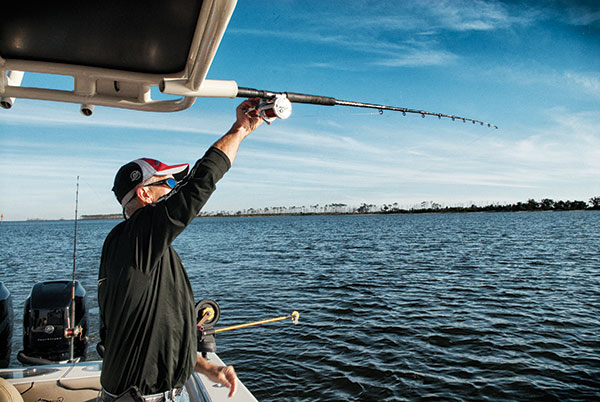
Go Sideways
Kingfish live-bait rigs are built with light wire leaders and small treble hooks, so when a king strikes, it will come tight immediately to set the hook. The last thing you want is the slack line caused by the drop-back when using an outrigger. It will cost untold missed strikes. To spread your trolling pattern and set out some long baits, kingfish boats are equipped with a pair of rod holders mounted horizontally and out to the sides of the T-top. It has become standard equipment on most midsize and larger center consoles.
Successful king mackerel fishing often requires long runs, and if you’re in competition, that means as fast as you can go. It stands to reason that kingfish boats, whether open (unlimited) class or small-boat (under 27 feet) class, are designed for speed and seaworthiness. In recent years, step hulls have become all the rage for increased performance. Clayton Kirby, a two-time SKA Angler of the Year, has been fishing kingfish competitively since 1979. Fountain Powerboats hired him in 1986 because of his long string of tournament wins and his knowledge of what makes a great tournament boat.
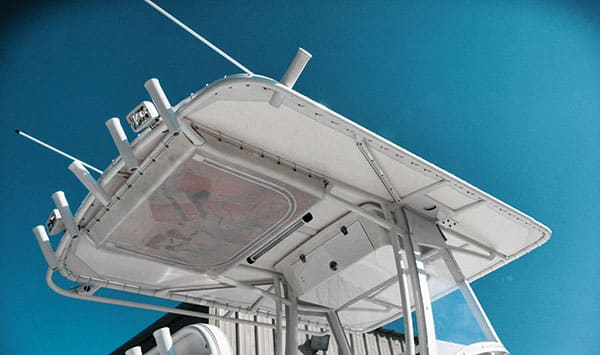
Stepping Up
“Fountain was the first manufacturer to offer a step hull on a competition fishing boat,” Kirby tells me. “That was 13 years ago when they adapted the hull of the Lightning race boats to the 38-foot center console with triple outboards, and created a tournament boat that ran away from pretty much everything on the water!”
Steps began to catch on, and with good reason; they aerate the boat bottom, reducing friction with the surface, gaining up to 15 percent in speed without additional power, with a noticeable reduction in fuel consumption. Contender Boats built tournament center consoles before SKA came on the scene. Les Stewart Jr., marketing manager, says Contender offers step hulls on all models from 30 feet up.

“The step increases speed over a deep-V hull by about 10 percent, while reducing fuel consumption by 18 percent,” he says.
Other features of a great kingfish boat are loads of storage, big fish boxes, the latest electronics, and beanbag chairs to make those long hauls to the fishing grounds a tad less physically stressful on the crew. Center consoles have come a long way since the introduction of the 1961 Boston Whaler Nauset, and many of the design features fishermen take for granted today are the result of innovations designed for competition kingfish boats. Sometimes the march of progress can be a good thing all the way around.

